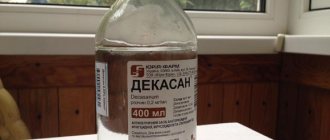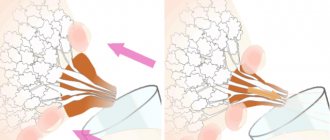Concept and characteristics
Omphalitis in newborns - photo:
Omphalitis is an infectious disease that occurs mainly in newborns in the first weeks of their life. The pathological process leads to inflammation of the subcutaneous tissue and skin around the umbilical ring.
The disease has characteristic symptoms, so a doctor can make a preliminary diagnosis during a visual examination of the baby.
Treatment of omphalitis should be carried out immediately. Otherwise, the inflammation may spread to the child’s internal organs.
How does infection occur?
In most cases, the causative agent of omphalitis is Staphylococcus aureus (almost 80%). Less commonly, E. coli and streptococci can provoke the disease.
As a result of pathogenic microorganisms entering the umbilical wound, they spread not only through the skin in a certain area, but also into the peritoneum, as well as the internal organs of the baby.
The main factor that increases the risk of infection is the lack of treatment of the umbilical wound in the first days of a newborn’s life.
ICD 10 code: P38 Omphalitis of the newborn with little or no bleeding.
An umbilical wound can become infected in several ways.
The infection can be a consequence of other pathological processes in the newborn’s body or get into it through contact and household contact.
Before treating a wound, you must wash your hands thoroughly and prevent it from getting dirty. Otherwise, the risk of infection increases several times. In addition, the source of infection can be contact with an infected person. In this case, hand washing will not help prevent infection.
What to do?
As a rule, the mother is advised to strengthen the means used for treatment, as well as to increase the frequency of hygiene measures. If a healthy baby with a normally healing navel undergoes manipulation up to two times a day, then in the presence of putrefactive processes their number increases to four per day.
Medicines for treating the umbilical wound
- First, a few drops of hydrogen peroxide (3%) are injected into the wound. Sometimes the navel is closed for physiological reasons or due to drying pus - in this case it must be carefully opened with your fingers. If there is a lot of discharge, after the first instillation you can do a second one, after blotting the liquid with a sterile cotton wool or bandage. Instead of peroxide, you can use a Furacilin solution to wash the wound (a crushed tablet is dissolved in half a glass of boiled water, cooled to 60-70 degrees). The powder can also be diluted with saline solution, which is sold at the pharmacy;
- be sure to wait for the wound to dry;
- treat with an antiseptic. If brilliant green is used, then it is taken with a pipette or syringe and instilled in a small amount directly into the area of inflammation. But since we are talking about suppuration, it is better to give preference to more powerful means, for example, Miramistin, Chlorophyllipt, Baneocin or others;
- in rare cases, the doctor may decide to prescribe medications orally. These can be vitamins B and C, as well as antibiotics.
It is strictly prohibited to use medications for internal use without a doctor’s permission!
Let's talk about a number of preventive measures that will prevent the inflammatory process from occurring:
- It is forbidden to pick the wound with a cotton swab or other objects - all movements must be careful and slightly tangential. Antiseptics can only be applied by dripping onto the skin;
- The greater the access of oxygen to the wound surface, the faster it heals. Under no circumstances should you cover your navel with a band-aid so that “dirt doesn’t get in.” You should avoid wrapping the baby, and until the diaper is completely healed, you must either tuck it in front or choose special models with an anatomical cutout;
- the person carrying out the treatment should wash their hands thoroughly, preferably with antibacterial soap;
- if water gets on the wound (bathing, the baby peed unsuccessfully, etc.), all treatment procedures are repeated;
- applying bandages with antiseptic ointments is also not recommended;
- the treatment is carried out on the first day after returning from the maternity hospital, and does not wait until the clothespin falls off. Since it is in the way, you need to carefully move it away with your hand.
Physiotherapy and folk remedies
Physiotherapy procedures in a special medical office are carried out if the baby is diagnosed with omphalitis.
Apply:
- Microwave therapy;
- ultraviolet irradiation;
- helium-neon laser treatment;
- cauterization with silver nitrate.
As a result of such manipulations, pathogenic microflora is disinfected and destroyed.
In most cases, the procedures are highly effective. If they do not bring a positive result, a blood transfusion may be attempted.
Regarding the use of folk remedies, we can say the following: if problems arise with the health of the newborn, it is better not to experiment, but to trust the proven methods of treatment prescribed by the pediatrician. In order to dry and activate local immunity, you can use the Minin reflector (“blue lamp”) to heal the umbilical wound. This is a safe and effective device, but you should start using it only after consulting with the doctors who are caring for the newborn.
It is also possible to additionally use a decoction or infusion of chamomile to disinfect bathing water.
But here, too, it is important to ensure that no excess debris gets into the bath (the folk remedy must be filtered through gauze folded in several layers)
Causes
Omphalitis most often occurs in children with critically weakened immune systems .
At risk are premature babies and babies born as a result of difficult labor.
The bodies of such babies cannot fully resist infections. The cause of the development of the inflammatory process can be the slightest deviation from the treatment regime for the umbilical wound to speed up its healing.
The following factors can cause omphalitis :
- consequences of intrauterine infections;
- infection in the umbilical wound during a medical examination;
- excessive looseness of the subcutaneous fat layer in a newborn;
- insufficient care of the umbilical wound (or lack thereof);
- consequences of folliculitis in a newborn;
- hereditary factors (genetic predisposition);
- the child has abnormalities in the development of the abdominal wall;
- development of pyoderma in a newborn;
- poor social and living conditions.
Growth at the navel
After cutting the umbilical cord, a stump forms in a newborn baby. If an infection gets into that place, the wound does not heal and fall off as quickly as under normal circumstances. Sometimes a growth appears at the navel, which brings some discomfort. You should consult a doctor about this problem, as it can lead to negative consequences. The growth occurs due to the proliferation of granulation tissue. If bacteria get into it, complications of this disease appear.
Therefore, it is important to identify the problem in time and seek qualified help from a doctor.
Types of growths on the navel and their causes
The exact reasons for the appearance of growths in the navel are still unknown. Girls and boys under one year of age are equally susceptible to the growth of granulation tissue. This reaction is a feature of the adaptation of a growing organism, and not an infectious process. Doctors associate the appearance of umbilical growths with a wide umbilical ring in a child. Although this phenomenon is considered normal, after the umbilical cord is separated, the free space begins to fill with fungus. Doctors believe that granuloma in the navel area is a disease that must be gotten rid of.
There are several types of navel growths:
- wen;
- umbilical hernia;
- malignant formations;
- omphalitis.
Wen or lipoma of the navel is quite rare. It is a benign formation a couple of centimeters in size, which looks like a pimple. The cause of its appearance is considered to be a blockage of the sebaceous gland duct in the navel area. Wen is characterized by slow growth and the absence of an inflammatory process. A umbilical hernia is a protrusion of sections of intestine through the umbilical ring, which becomes more noticeable when coughing or laughing. The rarest type of lump in the navel is considered to be a malignant formation that develops due to metastasis of tumors in other organs. If the previously mentioned problems occur in adults, then omphalitis occurs only in children. This disease occurs due to infection of the remainder after cutting the umbilical cord in a newborn.
Diagnostics
Diseases are diagnosed by examination by a doctor. The doctor must find out when the tissue proliferation began and what accompanying symptoms are present in the patient. After the examination, blood tests are taken to detect the inflammatory process. In advanced cases, it is necessary to do an ultrasound examination and an X-ray of the navel. A decision on a treatment method should be made only after a reliable diagnosis has been made.
Neoplasms
If a formation is detected in the navel area, you should contact a surgeon. The examination can also be carried out by a local physician, who will refer you for further examination. If the abscess is suspicious and there is a possibility of its malignancy, only an oncologist should carry out treatment. To determine the type of formation, it is necessary to do an ultrasound and x-ray. Sometimes they are sent for gastroscopy. Once an accurate diagnosis is made, surgical excision is performed in most cases.
Fungus in a child
Most often, fungus treatment in infants is carried out at home. The main thing that needs to be monitored is careful care of the wound and cauterization of formations. To achieve the desired effect, the procedure must be repeated every day.
Also, for speedy healing, it is important to ensure that the growths do not come into contact with the diaper.
| Methods of treating fungus in children | |
| Umbilical toilet | The umbilical wound must be thoroughly washed with water every day. |
| Antibiotics | If necessary, use antibacterial agents in the form of ointments, creams, solutions or sprays. |
| Hydrogen peroxide | A peroxide solution is instilled into the washed wound. |
| Zelenka, potassium permanganate or iodine | Treat the growth with disinfectant solutions. |
| "Chlorophyllipt" | The advantage of treating with an alcohol solution of Chlorophyllipt or another colorless antiseptic is that they do not stain the skin. Thanks to this, it is possible to notice inflammation in time. |
| Regular salt | Twice a day, salt is poured into the wound, sealing it with a band-aid. After 30 minutes, the navel is washed with water. |
If home treatment with conservative methods does not produce results, it is necessary to resort to surgery.
Umbilical hernia
It is strictly forbidden to try to get rid of this disease on your own. The first thing you should do is see a doctor who can repair hernias. If reduction cannot be achieved, then the formation is removed surgically. If the umbilical hernia is pinched or inflamed, the patient needs urgent medical attention.
Classification and forms
Omphalitis in newborns can be primary and secondary. In the first case, the disease develops against the background of infection of the umbilical wound .
The cause of secondary omphalitis is the presence of congenital or acquired pathologies in the newborn.
Additionally, the disease is divided into simple and advanced forms depending on the degree of progression of the inflammatory process.
According to the nature of the course, omphalitis is divided into the following types:
- Phlegmonous type (a dangerous form of omphalitis in which pathogens penetrate neighboring organs).
- Necrotic form (the rarest form of the disease, the inflammatory process causes tissue death in a certain area of the skin, the umbilical ring takes the form of an extensive wound);
- Catarrhal or serous appearance (the simplest form of the disease; a grayish liquid is released from the umbilical wound);
- Purulent form (this type of disease is a complication of a simple form; pus is released from the umbilical wound).
What can omphalitis be like?
Based on the nature of inflammation, the following forms of omphalitis are distinguished:
- catarrhal;
- purulent;
- phlegmonous;
- necrotic.
Catarrhal omphalitis
With this form, fluid is constantly released from the navel, which is why it is often called a “weeping navel.” Periodically, the wound becomes covered with a crust. In some cases, slight redness and swelling may occur around the belly button. When palpating the peri-umbilical area, the vessels are not palpable (cannot be felt under the hand).
Please note that with catarrhal form, the general condition of the baby is not disturbed. The baby is active, eats well, and his body temperature is normal.
This is the only form of omphalitis that can be treated at home. All others are being treated in the surgical department of the children's hospital.
Purulent omphalitis
Purulent omphalitis is characterized by the development of edema (swelling) and hyperemia (redness) of the umbilical ring. The skin around the navel is hot to the touch. In this case, purulent contents are released from the wound. There may be an unpleasant odor coming from the navel. In some cases, palpation reveals inflamed umbilical vessels.
If the child’s well-being is not severely affected, you can be treated at home under the constant supervision of your pediatrician. But if your doctor strongly recommends hospital treatment, don't refuse. It is better to be treated in a department under constant supervision than to develop serious complications.
Phlegmonous omphalitis
Phlegmonous omphalitis occurs when the inflammatory process spreads and involves the peri-umbilical area.
With omphalitis of this form, the swelling increases, the skin in the navel area is hyperemic, the umbilical area protrudes, as if rising above the tummy. The vessels of the anterior abdominal wall dilate, and the venous pattern on the abdomen is clearly visible. In some cases (if the crust is not removed during treatment), an ulcer with uneven edges and fibrin deposits (white, film-like structures) may form at the bottom of the wound in the navel.
Necrotizing omphalitis
Necrotizing omphalitis is a complication of the phlegmonous form, which, fortunately, is extremely rare. But it still occurs in severely weakened and premature babies.
The inflammation process penetrates deeper. The baby's skin becomes purple and bluish. Necrosis (death) of the skin occurs, and it peels off from the underlying tissue, forming a large wound. Inflammation can spread to the abdominal muscles and even the intestines. This form is very severe and dangerous because it can lead to sepsis (infection entering the blood). The general condition of the child with this form is serious.
Symptoms, signs and clinical picture
Healing of the umbilical wound should occur within a maximum of two weeks. In some cases, this process may be accompanied by the formation of small yellow crusts .
This nuance is not a pathology, but when any discharge appears, there is a risk of infection. This symptom is accompanied by suppuration of the wound. Additional signs of omphalitis gradually develop.
If they appear, you should consult a doctor as soon as possible.
Symptoms of omphalitis appear in the following conditions:
- redness of the skin around the umbilical ring;
- too long healing of the umbilical wound;
- blue tint of the skin around the newborn's navel;
- the appearance of a rash around the umbilical ring;
- swelling of the tissue around the navel;
- discharge from the umbilical wound;
- tearfulness and capriciousness of the child;
- poor appetite;
- increase in body temperature.
How to recognize a hernia of the linea alba in newborns? Read about it here.
Symptoms
The main symptom of the disease is the presence of a mushroom-shaped protrusion. At the initial stage of its growth it is practically invisible. When small nodules (or one larger nodule) increase in size, they can be noticed during daily hygiene of the umbilical wound, after bathing. Fungus is characterized by the following symptoms:
- the color is pale pink, less often red or burgundy;
- consistency is dense, homogeneous;
- the structure resembles a mushroom (single node on a thick base) or a bunch of grapes (nodular structure);
- painless on palpation;
- slow growing.
With an uncomplicated course of the disease, there are usually no general symptoms. The child can react only when the formation is treated or it is injured by clothing (diaper, toy).
When an infection occurs and omphalitis develops, the following are possible:
- tearfulness and bad mood;
- increased body temperature;
- poor sleep;
- general malaise;
- loss of appetite and weight loss;
- soreness, swelling, hyperemia and local increase in temperature in the umbilical area;
- discharge from the navel of various types;
- local vascular changes.
If the inflammatory process is left untreated, bacteria can enter the general bloodstream and cause sepsis. This condition will pose a threat to the child’s life.
To prevent this, it is important to diagnose omphalitis in a timely manner and begin therapeutic measures.
Complications and consequences
Omphalitis is one of the dangerous diseases .
If the inflammatory process has not been eliminated, resulting in its spread throughout the child’s body, then any internal organs can impair the performance.
The infection affects the intestines, lungs, endocrine system, blood and lymph nodes. Against the background of illness, the baby increases the risk of contracting other infectious diseases, including pneumonia.
Some of these diseases are deadly and can cause death in a newborn.
Complications of omphalitis may include the following consequences:
- inflammation of bone tissue (osteomyelitis);
- damage to the inflammatory process of arteries and veins;
- abscesses of internal organs;
- sepsis (blood poisoning);
- lymphangitis (inflammation of the lymph nodes);
- pneumonia (lung infection);
- peritonitis (development of an inflammatory process in the peritoneum);
- intestinal damage (enterocolitis).
What are the consequences of hemorrhagic disease of the newborn? Find out the answer right now.
Diagnostics
Diagnosis of omphalitis does not involve difficulties for a specialist.
A doctor can recognize signs of the disease based on external signs of the inflammatory process.
Additional procedures are prescribed to determine the stage of development of the infection and the degree of damage to the newborn’s body.
Data from such studies are necessary to develop a course of treatment for the disease. If treatment is carried out incorrectly, the risk of complications will increase .
Diagnosis of omphalitis is carried out using the following procedures:
- bacterial culture of discharge from the umbilical wound;
- biochemical analysis of blood and urine;
- Ultrasound of soft tissues and abdominal cavity;
- general blood and urine analysis;
- plain radiography of the abdominal cavity.
Treatment
How to treat a baby? When treating omphalitis, doctors can use several treatment regimens .
The key role is played by the general condition of the child, the individual characteristics of his body, the stage and degree of development of the disease, as well as the presence of additional diseases against which the baby became infected.
Treatment can be carried out in a hospital setting or at home. To prescribe a specific course of therapy, a preliminary and complete examination of the newborn is necessary.
Local
Local treatment of omphalitis consists of eliminating the inflammatory process with antiseptic solutions .
This form of therapy is permissible only in the absence of complications of the disease.
Treatment can be carried out at home, but if there is suspicion of the spread of infection, the newborn is placed in a hospital. A specialist must determine the need for hospitalization of a child.
Local treatment consists of the following procedures :
- It is necessary to drip a few drops of hydrogen peroxide into the wound (the remaining liquid is carefully removed with a cotton swab or disk).
- Treatment of the umbilical wound with drugs from the group of antiseptics (Chlorophyllipt, Furacilin, brilliant green solution).
- Additionally, you can treat the skin with herbal infusions (for example, a decoction of calendula or chamomile).
- When fungus forms, cauterization using silver nitrate is recommended.
- When bathing a newborn, it is recommended to add several crystals of potassium permanganate to the water.
Systemic
The need for systemic treatment of omphalitis arises in the presence of complications of the inflammatory process.
In this case, the only way to eliminate the infection is to use antibiotics.
Drugs in this category can be prescribed in the form of ointments or other forms of release. Under no circumstances should you select them yourself. The need to use antibiotics should only be determined by a doctor .
Systemic treatment of omphalitis consists of the following procedures :
- antibiotics (combination of Oxacillin with Gentamicin);
- antiseptic ointments (Bactroban, Vishnevsky ointment);
- vitamin complexes (vitamins A, B and C);
- means to enhance immunity (Immunoglobulin);
- intravenous administration of glucose solution (helps to avoid intoxication of the newborn’s body).
Physiotherapeutic
physiotherapeutic procedures are widely used , which help to significantly speed up the child’s recovery process.
A newborn may be prescribed treatment of the umbilical wound with a helium-neon laser, ultraviolet irradiation, UHF therapy or microwave.
The procedures do not cause pain to the baby and are well tolerated . It is up to the physician to determine the need for a specific type of physical therapy.
Surgical
If there are complications or necrotic tissue damage around the navel, in most cases there is a need for surgical intervention .
This procedure is mandatory in case of the formation of fungus, umbilical-vesical fistula, extensive phlegmon of the abdominal cavity, or the absence of results from the therapy.
After an operation to open the abscess or remove dead tissue, the child is prescribed additional treatment to speed up the wound healing process.
Recommendations for the treatment of vesiculopustulosis in newborns can be found on our website.
Processing agents
In difficult situations, treatment of the umbilical cord for omphalitis is performed by nurses in the hospital. For this use:
- three percent hydrogen peroxide solution;
- five percent solution of potassium permanganate;
- one percent solution of brilliant green;
- medical alcohol.
Hydrogen peroxide for navel treatment
Do not apply brilliant green to the skin, this will complicate the diagnosis
If the child’s condition is stable, the same technique for disinfecting the umbilical wound with omphalitis can be used at home. Additionally, you will need sterile cotton swabs, gloves and a pipette, a bowl for waste material, and a clean changing kit.
Features of baby care
During the period of treatment of omphalitis, the child is provided with special care .
All doctor’s recommendations must be followed without violation.
If the baby’s mother is sick with an infectious or viral disease, then the treatment of the umbilical wound should be entrusted to a healthy person .
Otherwise, an additional infection may join the child’s existing inflammatory process. Bathing your baby is done with the utmost care. Under no circumstances should injury to the wound be allowed.
What is umbilical fungus?
Umbilical fungus is common in newborns. This disease is common throughout the world among both boys and girls. It is usually noticed by parents when they bathe the baby and treat the umbilical cord. The high incidence of this part of the body in newborns is due to the fact that this place connected mother and child for a long time and contributed to nutrition. In the first minutes of life, the umbilical cord is cut, leaving a stump in its place. Normally, it dries quickly and falls off. But in some cases, the wound takes a long time to heal because it becomes infected. Umbilical fungus is a proliferation of granulation tissue. It develops as often as omphalitis. In some cases, granulations can become infected. This occurs due to the penetration of bacteria into the tissue. Then complications of the disease are possible.









